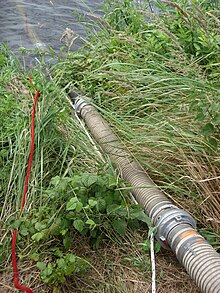Suction point
The suction point is a removal or transfer point for the fire brigade or for other possibilities. This happens through a suction line , a hose or pipeline for sucking in or filling a liquid or a gas . This is part of the fire fighting water supply .
Condition and structure of the suction point
The distances between the tapping points must be chosen so that all the objects to be protected can be supplied with extinguishing water by the local fire fighters.
Paved driveways must be accessible to vehicles with an axle load of 10 t in all weathers.
The suction height should be kept as low as possible and not exceed 5 m.
The immersion depth (covering of the suction strainer) must be approx. 30 cm with a water flow of 800 l / min and at least 50 cm with 1600 l / min.
The extinguishing water points must be usable immediately even in frosty conditions.
The suction line
An essential part of a suction point is the suction line, which is either permanently installed or only designed when required. A suction line in the area of the fire brigade is understood to be the entire line from an open water extraction point to a fire extinguishing pump in order to obtain extinguishing water . The negative pressure that occurs during operation is characteristic of a suction line .
Structure of the suction line
The German fire service regulation describes the suction line as follows:
- The suction strainer and (usually) the suction protection strainer
- A valve rope that is attached to the suction head with a snap hook . It offers the possibility of opening the non-return valve by pulling hard and thus emptying the suction hoses. This is done before dismantling the suction line to reduce the weight when lifting it out (approx. 15 kg of water per hose with the usual A suction hose).
- Optionally a tether to secure the suction hoses . It is attached to the couplings with half strokes and can thus be used to pull the suction hoses out of the water. In the event of the suction line breaking apart, it prevents the suction hoses from being lost.
- The dimensionally stable suction hoses, which are available in sizes A, B and C.
Web links
Individual evidence
- ↑ Fire Brigade Service Regulations 1 Basic Activities - Extinguishing and Assistance (with editorial additions until March 2007) Federal Office for Civil Protection and Disaster Assistance , 2007 (pdf, 10 MB) accessed on April 14, 2017.
- ↑ EN ISO 14557.

